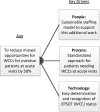Improving delivery of EPSDT well-child care at acute visits in an academic pediatric practice
- PMID: 22987871
- PMCID: PMC9923557
- DOI: 10.1542/peds.2012-0355
Improving delivery of EPSDT well-child care at acute visits in an academic pediatric practice
Abstract
Background and objective: Many patients with Medicaid do not receive timely, comprehensive well-child care through the Early and Periodic Screening, Diagnosis, and Treatment (EPSDT) program. Missed opportunities for EPSDT well-child check-ups (WCCs) at acute visits contribute to this problem. The authors sought to reduce missed opportunities for WCCs at acute visits for patients overdue for those services.
Methods: A quality improvement team developed key drivers and used a people-process-technology framework to devise 3 interventions: (1) an electronic indicator based on novel definitions of EPSDT status (up-to-date, due, overdue, no EPSDT), (2) a standardized scheduling process for acute visits based on EPSDT status, and (3) a dedicated nurse practitioner to provide WCCs at acute visits. Data were collected for 1 year after full implementation.
Results: At baseline, 10.3 acute visits per month were converted to WCCs. After intervention, 86.7 acute visits per month were converted. Of 13801 acute visits during the project, 31.2% were not up-to-date. Of those overdue for WCCs, 51.4% (n = 552) were converted to a WCC in addition to the acute visit. Including all patients who were not up-to-date, a total of 1047 acute visits (7.6% of all acute visits) were converted to comprehensive WCCs. Deferring needed WCCs at acute visits resulted in few patients who scheduled or completed future WCC visits.
Conclusions: Implementation of interventions focused on people-process-technology significantly increased WCCs at acute visits within a feasible and practical model that may be replicated at other academic general pediatrics practices.
Conflict of interest statement
Figures





Similar articles
-
The early and periodic screening, diagnosis and treatment program: opportunities for nurse practitioners.Nurse Pract. 1995 Aug;20(8):68-70, 72-3. Nurse Pract. 1995. PMID: 9019692
-
Barriers to the use of preventive health care services for children.Public Health Rep. 1996 Jan-Feb;111(1):71-7. Public Health Rep. 1996. PMID: 8610196 Free PMC article.
-
EPSDT preventive services in a low-income pediatric population: impact of a nursing protocol.Clin Pediatr (Phila). 2008 Mar;47(2):137-42. doi: 10.1177/0009922807306167. Epub 2007 Sep 14. Clin Pediatr (Phila). 2008. PMID: 17873239
-
Medicaid's EPSDT Benefit: An Opportunity to Improve Pediatric Screening for Social Determinants of Health.Med Care Res Rev. 2021 Apr;78(2):87-102. doi: 10.1177/1077558719874211. Epub 2019 Sep 15. Med Care Res Rev. 2021. PMID: 31524053 Free PMC article. Review.
-
Early and periodic screening, diagnosis, and treatment and managed care.Annu Rev Public Health. 1998;19:507-25. doi: 10.1146/annurev.publhealth.19.1.507. Annu Rev Public Health. 1998. PMID: 9611631 Review.
Cited by
-
Application of quality improvement approaches in health-care settings to reduce missed opportunities for childhood vaccination: a scoping review.Hum Vaccin Immunother. 2019;15(11):2650-2659. doi: 10.1080/21645515.2019.1600988. Epub 2019 Apr 22. Hum Vaccin Immunother. 2019. PMID: 30945976 Free PMC article.
-
Partnering health disparities research with quality improvement science in pediatrics.Pediatrics. 2015 Feb;135(2):354-61. doi: 10.1542/peds.2014-2982. Epub 2015 Jan 5. Pediatrics. 2015. PMID: 25560436 Free PMC article.
-
Preterm Infant Attendance at Health Supervision Visits.Pediatrics. 2015 Oct;136(4):e794-802. doi: 10.1542/peds.2015-0745. Pediatrics. 2015. PMID: 26416939 Free PMC article.
-
Quality Health Care for Homeless Children: Achieving the AAP Recommendations for Care of Homeless Children and Youth.J Health Care Poor Underserved. 2017;28(4):1376-1392. doi: 10.1353/hpu.2017.0121. J Health Care Poor Underserved. 2017. PMID: 29176102 Free PMC article.
References
-
- Centers for Medicare and Medicaid Services. Early and periodic screening diagnosis & treatment. Available at: www.medicaid.gov/Medicaid-CHIP-Program-Information/By-Topics/Benefits/Ea.... Accessed January 17, 2012
-
- Maternal and Child Health Bureau. EPSDT & Title V collaboration to improve child health. Available at: mchb.hrsa.gov/epsdt/index.html. Accessed January 17, 2012
-
- Peters CP . EPSDT: Medicaid’s critical but controversial benefits program for children. NHPF Issue Brief. 2006; (819):1–24 - PubMed
-
- Pittard WB III , Laditka JN , Laditka SB . Early and periodic screening, diagnosis, and treatment and infant health outcomes in Medicaid-insured infants in South Carolina. J Pediatr. 2007;151(4):414–418 - PubMed
-
- Hakim RB , Bye BV . Effectiveness of compliance with pediatric preventive care guidelines among Medicaid beneficiaries. Pediatrics. 2001;108(1):90–97 - PubMed

